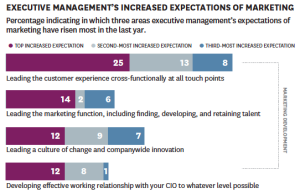Organizations are spending millions of dollars to “digitalize” themselves, as a way to become more agile and responsive to customer needs. As Gartner says, “Companies should be able to ‘react at Internet speed’ with real-time analytics to better understand individual buyers, and how to serve their unique needs.”
The payoff of these efforts is a more competitive and innovative organization that provides a consistent and engaging customer experience. As the organization become flatter and more transparent, it also brings a certain degree of risk. And, increasingly, that risk is falling on one group.
Yes, you guessed it: marketing.
According to HBR’s Designing a Marketing Organization for the Digital Age report, marketing is not only responsible for creating a consistent customer experience across the enterprise; perhaps even more challenging, it’s responsible for getting the organization to embrace change.
Ramping up the organization to operate at the new “Internet” speed of change is critical, according to McKinsey’s Cracking the Digital Code global survey. Forty three percent of executives surveyed said that high-performing digital companies go from idea to implementation in less than six months.
And let’s not kid ourselves about the herculean effort this may involve. Twenty five percent of executives who participated in the survey expressed concerns about their organization’s ability to keep pace, and its ability to adopt an “experimentation” mind-set required to make this transformation.
Marketing is, however, well equipped to take on the challenge; it has always advocated for customers and their experiences. Now it’s being empowered to take ownership of it across the entire enterprise. Marketing has long been the “tip of the spear” for digitalization, operating as the “hub” of digital interactions with customers for years. No other group has had to embrace and operate at the “speed of the Internet” like marketing has.
So it’s not surprising that 75 percent of marketers expect to be responsible for the customer experience, according to the Economist Intelligence Unit.
If marketers can successfully bring about the change needed to digitalize the organization, it should also yield additional organizational benefits that go beyond the customer experience. For example:
- Improving the culture. 89 percent of senior executives said that great companies build cultures that consistently create excellent customer experiences. Corporate culture also plays a critical role in attracting and retaining digital talent, according to McKinsey.
- Aligning customer service to the brand message. Although this has been discussed for years, companies are increasingly aligning the performance of customer service to brand health metrics, according to the HBR report. The Aberdeen Group also noted that when customer service is in sync with how marketing manages the brand, company revenues rises, as do social media mentions.
- A new organizational model. According to Frank van den Driest, author of The Global Brand CEO: Building the Ultimate Marketing Machine, in a digital world, marketing will evolve from expertise in “things” like television, ecommerce and media, to “thinkers” who excel at understanding and using data, “feelers” who are immersed in customer behavior and interaction, and “doers” who implement campaigns, creating content and measurement.
Given the importance of this digital transformation, improving the customer experience is now the No. 1 CEO expectation of their chief marketing officer, according to Gartner. For years, marketers have been asking for a seat “at the table,” and now they have it…and it’s a hot one.


